This past Saturday I took a short trip down to Enoshima, a small island just south of Kamakura that is famous for being home to Benzaiten, the deity associated with music and entertainment, and a popular travel destination for the Kantō region for hundreds of years. It’s also where the 1964 and 2020 Olympic sailing competitions were held. I’d been there once before several years ago. This time the plan was to meet two friends, one Japanese I shall refer to as Mr. A, the other Mr. L., a Korean/Canadian/American. Once there the plan was to just walk around, visit the three main shrines, have lunch, do some snacking, and maybe walk around some more.
There are two stations that serve Enoshima, Enoshima on the Enoden line that runs from Fujisawa to Kamakura, and Katase Enoshima Station on a branch of the Odakyū Enoshima Line that runs from Shinjuku through Fujisawa and beyond. The latter line and is a bit faster than the Enoden line when coming via Fujisawa; the platform is closer to the JR lines in Fujisawa Station and the get off station for Enoshima is a bit closer to the island. Either way, it takes just over an hour to reach the island from most of central Tokyo (an hour and fifteen minutes from my home in Nihonbashi).
You can reach the island from the mainland either by car or as we did by crossing a nearly 400 meter long bridge, which was a pleasant walk in the sunshine when we crossed, with some sailboats waiting for wind and surfers hoping for some waves off to our left, to the north. Before 1923 or so the island was accessible either by boat or by walking across a sandbar at low tide. The Great Kantō Earthquake of 1923 destroyed the sandbar while also lifting the entire island up some six meters; after that access was by walking over a wooden bridge until the modern one was built.
As with most destination temples and shrines in Japan, the first leg of our approach to the main shrines was up a narrow street lined with shops selling all kinds of snacks and a local, Enoshima beer, and various souvenirs. Because the Omicron variant of the Corona virus currently has recently led to a huge increase in infections and feelings of anxiety about being out in public, the street was quite deserted. We were able to easily walk without bumping into people, or having to navigate around other and made good time working our way up towards the top of the hill, some sixty meters above sea level. There is a lookout tower on top of the island, as well as a western style garden built by Samuel Cockling, a British merchant who was able to purchase much of the land on top of the island in the 1880s from Buddhist temples which were forced to “go out of business” thanks to the religious reforms of the Meiji government. We thought about going into the garden to see tulips and other flowers but ended up not.
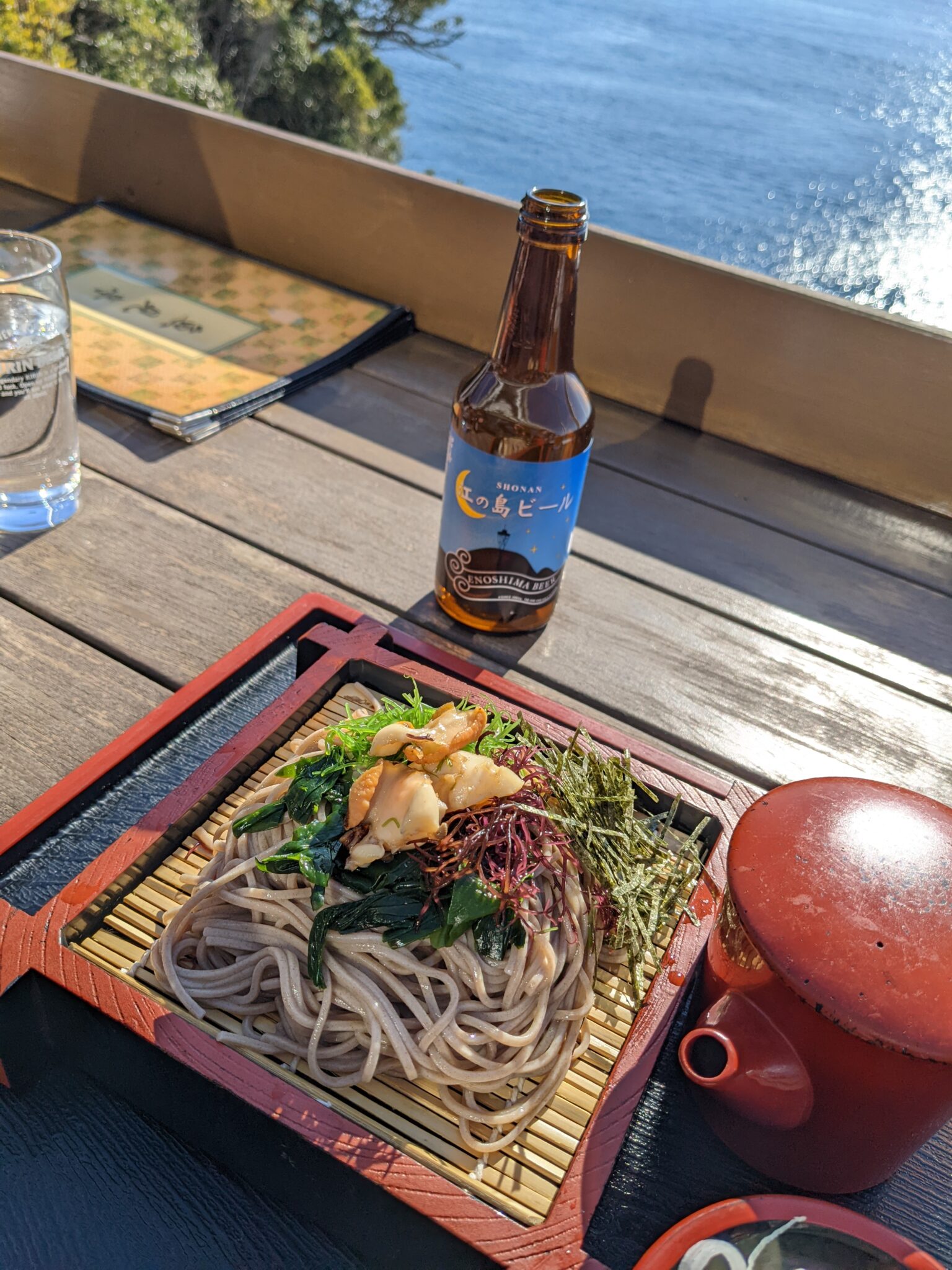
As we walked down the steps towards our goal, the Iwaya Caves, we stopped at Uomi-tei (魚見亭, https://enoshima-uomitei.com/), a little restaurant perched on the cliff above the ocean below, for lunch. I learned later that the restaurant has been in business since 1880 or so, over 140 years! We had to wait for five minutes or so for a table on the outside veranda, but it was worth it for the view of the sea crowded with fishing boats and Mt. Fuji off to the west. It was a bit after noon, and by this time Fuji had become slightly obscured by moisture in the atmosphere and clouds around its base after having earlier been fully in view. Looking at the menu as well as the plastic food on display outside, I got the feeling sazae (turban shell) was a specialty of not just this restaurant but of the island, so I decided to order the iso zaru soba. Iso (磯) means something like “a rocky beach,” which was what awaited us below. The dish consisted of cold soba topped with pieces of sazae, nori, wakame and other sea vegetables, served with a sazae dashi, according to the menu. My friends ordered other things. And despite the high price (¥690, which seemed to be standard at every shop), we ordered a couple bottles of Enoshima Beer, which turned out to be quite nice.
After lunch we walked down what seemed like a lot of steps to the ocean’s edge and the caves. I noticed a very small dog running up the stairs, and I figured that if he could do it with his tiny little legs then I could as well. On my previous visit to Enoshima I didn’t go into the caves. But this time we all paid our ¥500 and went on in. There was pretty good multi-lingual explanations of the caves’ geology and history posted along the walls, and it was all well-lit. Halfway in towards the deepest depth of the first, and bigger, cave there was a small booth with someone handing out hand-held candle lamps to light the way (children were given battery powered lights, not actual flames. The candle-lamp wasn’t really necessary as the cave could have been lit with electric lights as elsewhere. But it was kind of fun, and challenging to not extinguish the flame. There were some figures carved out of stone at the end of the cave, guarded by two more figures that looked more like the gargoyles that guard European cathedrals than anything I have seen in Japan. There was also a sign in Japanese and English say that this was where Enoshima Jinja (shrine) originated.
The next cave was brightly lit with small LED lights that covered the walls and ceiling of both tubes of the cave, the lights looking like thousands of fireflies in the dark. At the end was a dragon sculpture illuminated by slowly changing blue, red and purple colored lighting. After taking some photos we headed back towards daylight, this time via the other tube.
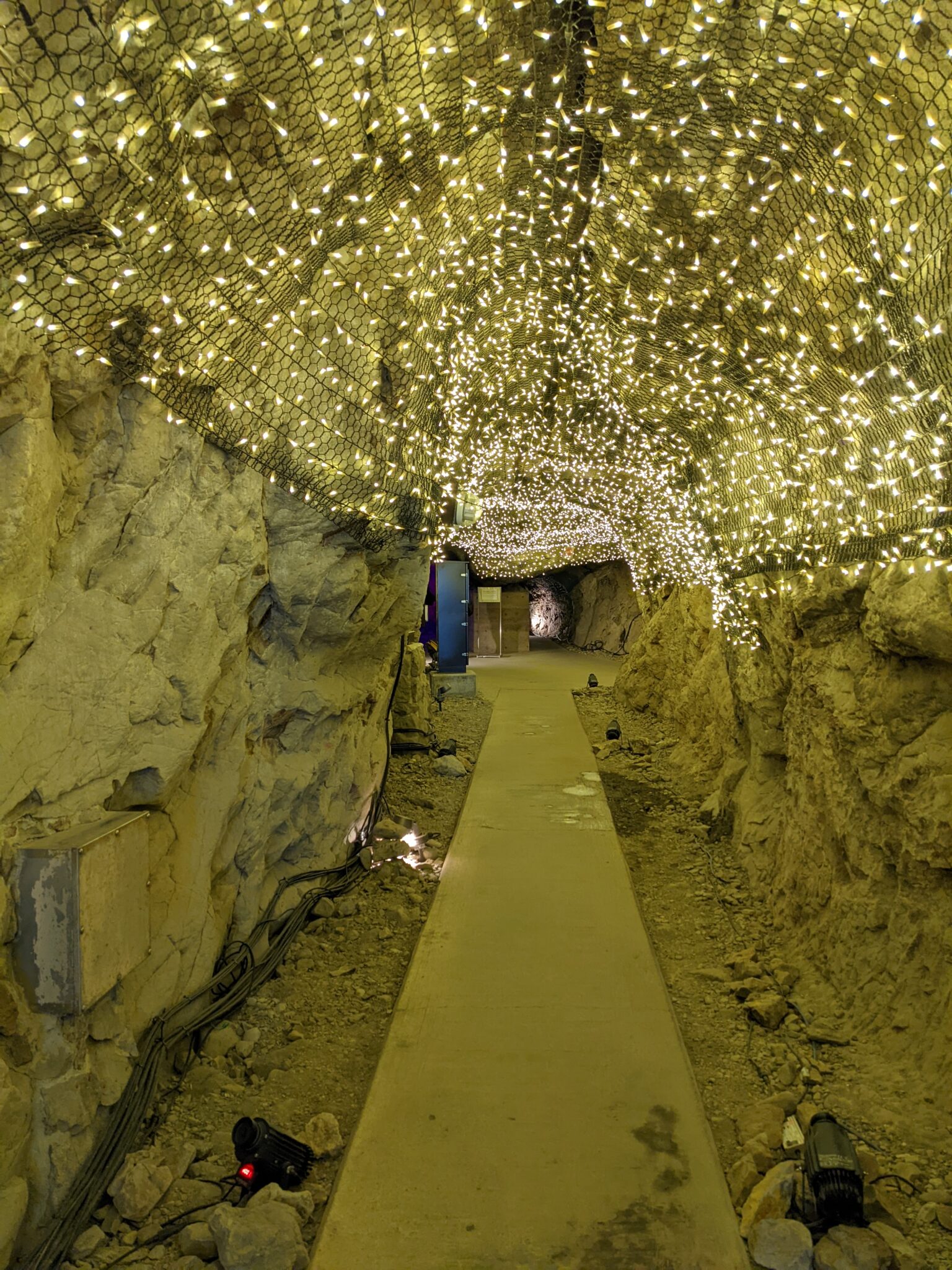
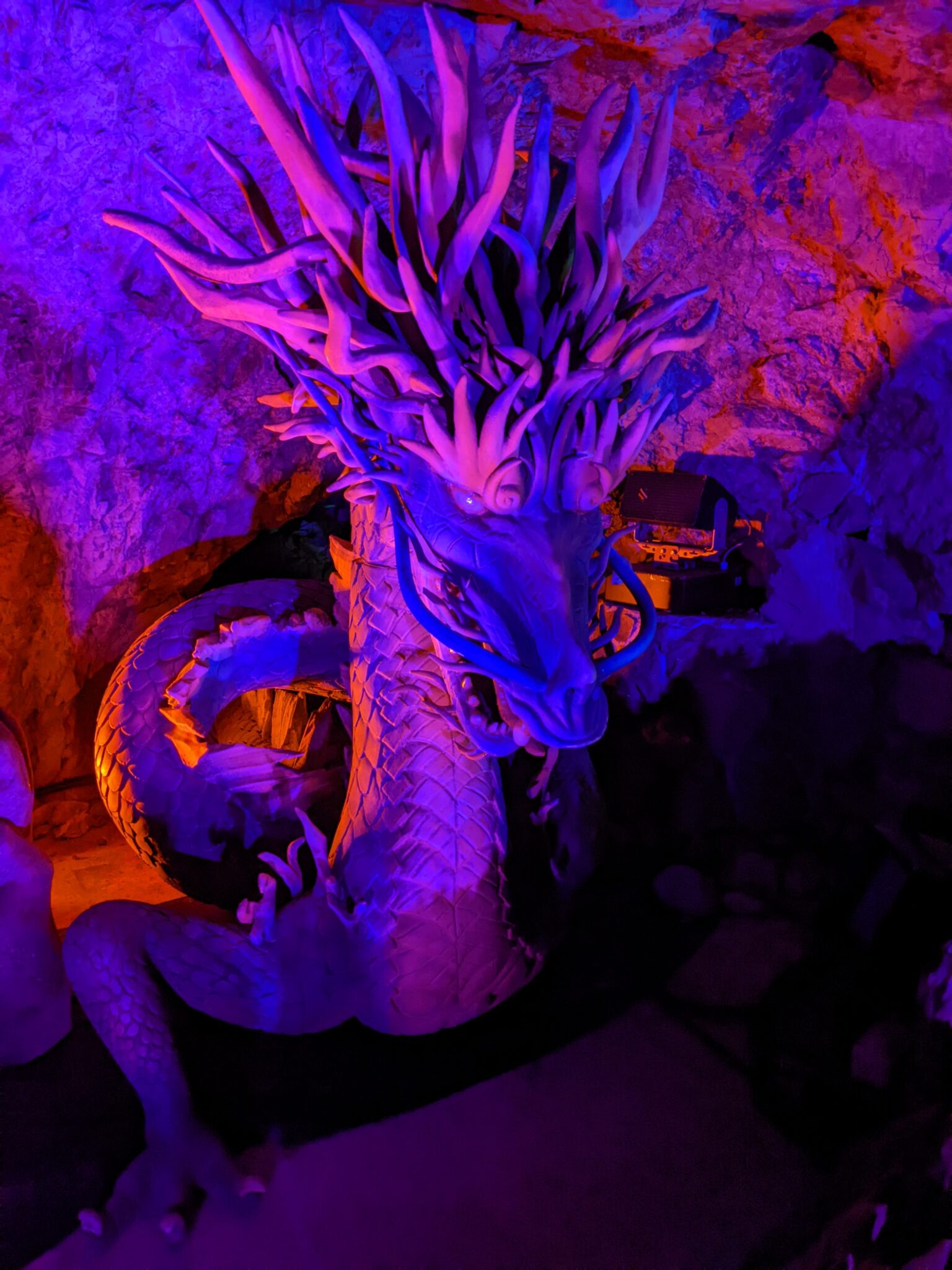
Later on, we discovered that Mr. A’s son and grandson had been in the cave at the exact same time, only in the other tube. We learned this after his son sent a photo of the same lit up cave taken exactly where we had also taken photos. When I compared the time stamp on the son’s photos to mine I saw that they were taken one minute apart, meaning the son was walking in as we were exiting. Small world!
Before heading back up the hill we walked around on the flat rocks that are just above sea level. There were people fishing, but with no fish being caught it was pretty boring to watch. Watching a couple of what looked to be teenage boys daring the incoming tidal surges to splash them was kind of fun, especially when they got splashed. And all the while there were tobi, Japanese black kites, circling overhead, waiting to steal some food from some careless visitor.
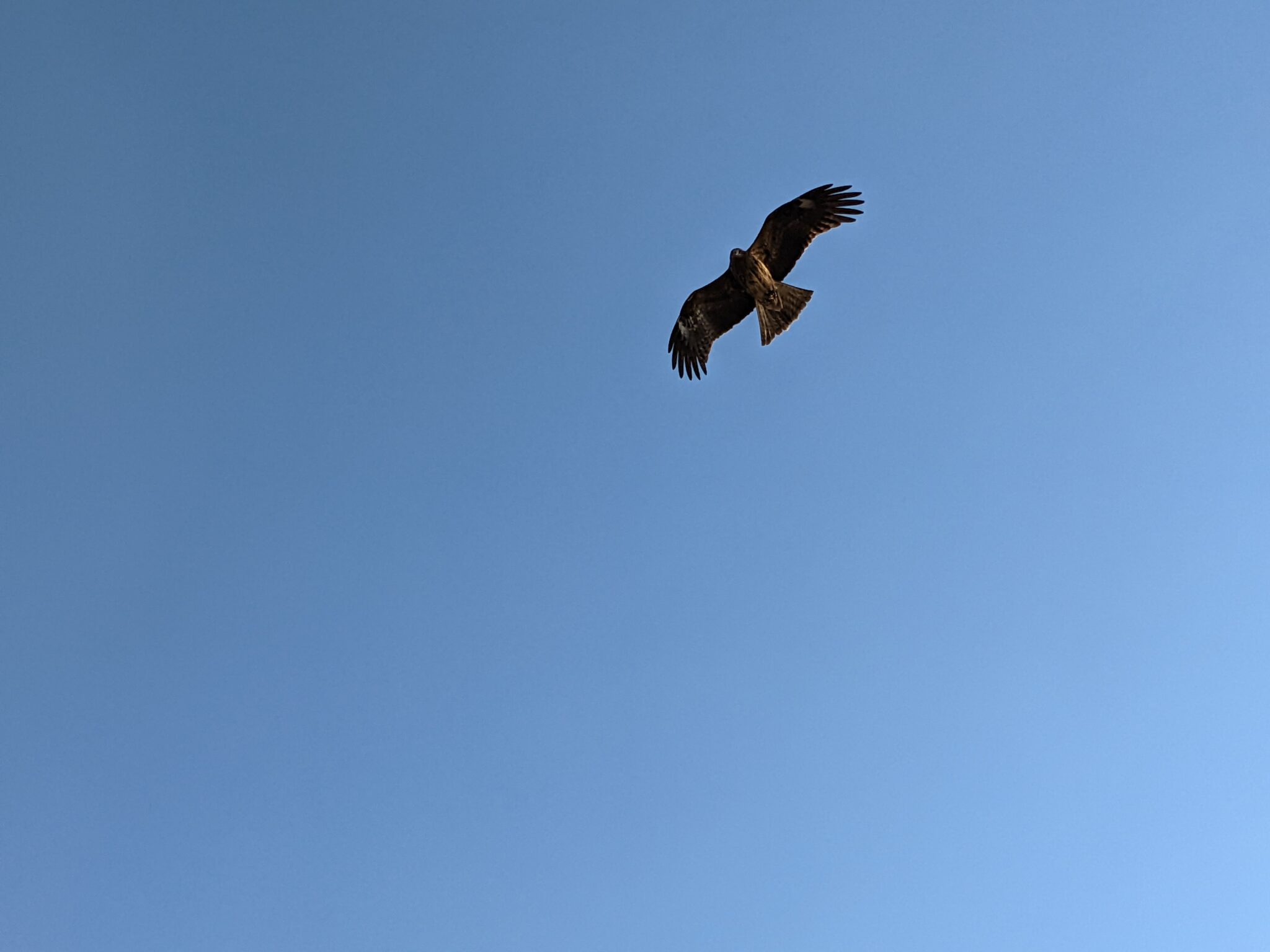

Back on top of the hill we saw some people eating large squares of what turned out to be tako (octopus) senbei. By large, I mean probably fifty centimeters square. We decided to get one, a half size for ¥400, plus an additional ebi (shrimp) senbei. We had to wait five minutes or so for our tako senbei to be made (the ebi was already made), which was an interesting five minutes. To make one of the giant, but very thin, senbei, first three or four pieces of small, whole octopus are put on a griddle, along with a small amount of batter. Then the lid is put down and a crank is turned to apply pressure on the mix. A minute or so later the lid is opened and more batter is added and the lid is cranked down once more. After this is done several times, some more batter is added to the corners so the senbei is square, the lid is once more cranked down, and then the senbei is ready, either as is or folded in two and broken, with each half again folded over, yielding a square around 30 cm per side. The fresh, and warm, tako senbei was much better than the cold ebi.
As we walked down towards the bridge we decided to stop for some sort of snack and some tea or coffee. We found a small shop, Nakamura-ya, that had macha sets with various wagashi (I had warabi mochi). The shop was actually on both sides of the narrow road and dated back some 120 years. It was a nice little break from walking up and down the slope, with some interesting historical material posted on the walls. On the walk down the hill we saw something very odd: a tanuki! It was just off of the path and appeared to be eating something before being spooked by us and running off. How it got onto the island is a mystery to me.
Mr. A and Mr. L. wanted to have a soak in the onsen near the entry to the island. Not being able to tolerate extremely hot water (anything over 40 C), I decided to ask how hot the water was before paying ¥1,500 to go in and discover it was too hot for me. When the person at the front desk said she thought it was 41 or 42 degrees I turned around and put my shoes back on, the three of us agreeing to meet back at the spa in an hour. It was still daylight, and quite warm outside as I started walking down towards the marina area. I was curious as to what was there besides boats, but ended up not making it all the way to the end due to something that caught my eye: A sign advertising shio (salt) beer. I had to try it.
When I walked up to the take-out stand in front of a restaurant called Tobiccho (とびっちょ, http://tobiccho.com/shops/tobiccho) and asked if the shio beer really had salt in it, the young woman working said yes, it did. So I handed over ¥650 and she gave me a cold one which I opened with my always present bottle opener keychain from the Lucky Lab pub in Portland. The beer wasn’t bad; light, as with most Japanese beers, with just a whiff of ocean breeze in the flavor from the locally produced salt that was added. I sat down on a seat and sipped on it, watching people come and go and petting a few dogs as well. The beer was good enough that I decided to try their other unusual beer, one with shirasu (oil) added. The shirasu flavor wasn’t as forward as the salt had been, but then again, it didn’t taste fishy at all. I also bought and ate a black shirasu korokke (croquette), which wasn’t bad and was warm in the rapidly cooling evening. I finally put on my sweater, glad that I had brought it along.
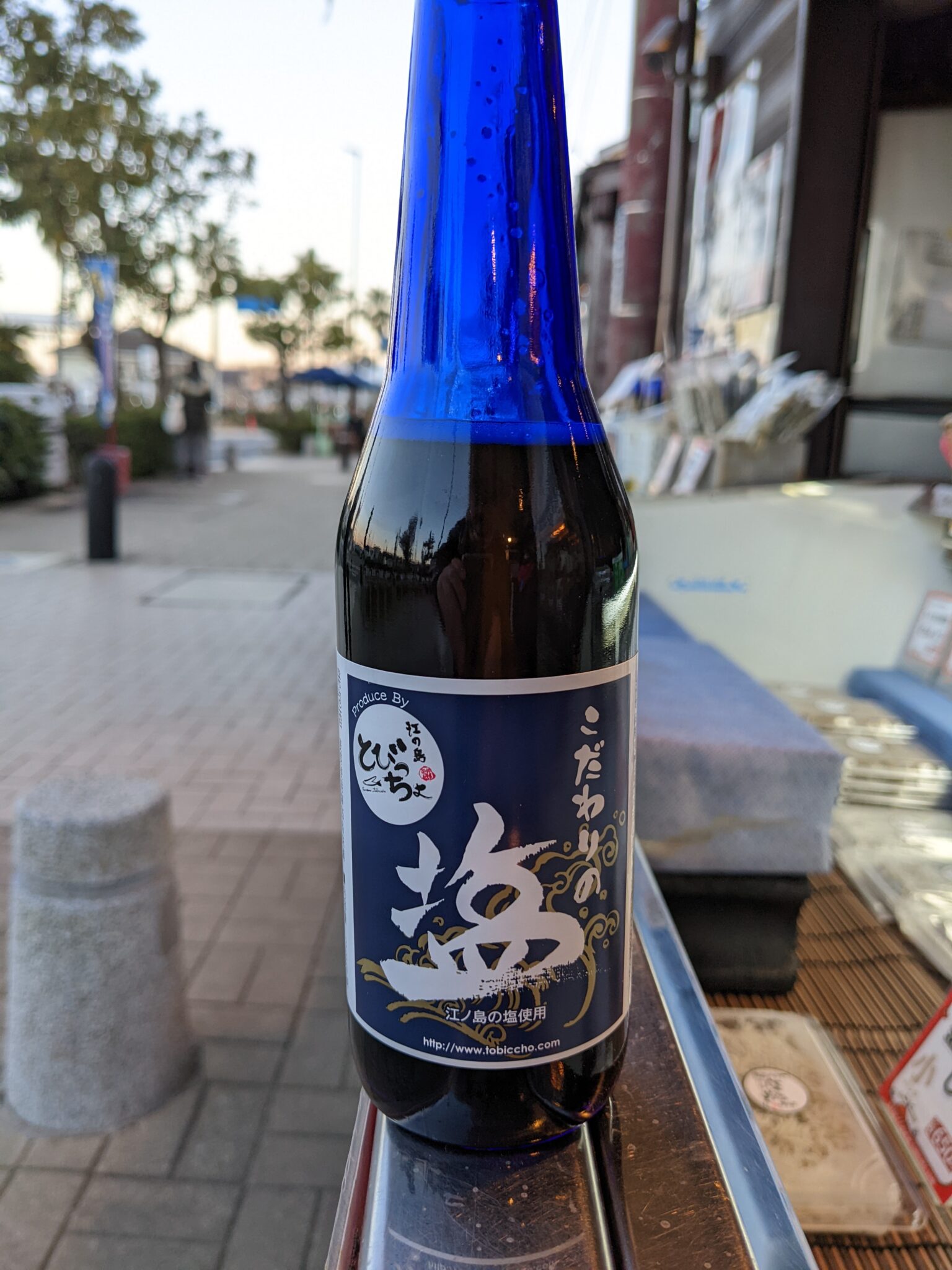

It being just about time to meet my friends, I headed back to the spa. We decided to have dinner together, but not on the island. On the train headed back towards Tokyo we decided to stop off in Kawasaki to look for a restaurant, finding a chain sake-bar izakaya, Hakobune, that was decent and not too expensive. Unfortunately, due to the recently reimplemented corona-virus rules, last order was at 8:00. So, thanks to our final dish, an order of kanburi shabu-shabu nabe, not being served until 8:30, we had only water to drink.
All in all, it was a fun day. And more fun with other people than going alone as I did the last time.